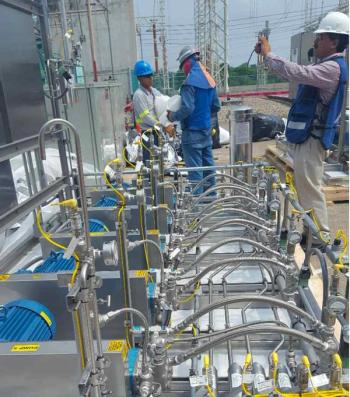
- March/April 2021
Energy transition to green uncertainty
Many attendees and speakers at the 39th Annual CERAweek wanted to know about the contemplated transition from fossil fuels to green energy. How fast will it happen? What has gone right so far? What could go wrong? Ask three energy experts, get three different answers. Ask three politicians, get nine different answers.
Imagine 21,000 of the top experts on oil, gas, LNG, electricity, and renewables, including their political advocates, being on the same Zoom call. That describes the 39th CERAWeek by IHS Markit. Often referred to as the “Davos for the Energy World”, CERAWeek is customarily held in Houston, Texas. After being cancelled in 2020 due to the pandemic, the latest version was held virtually in early March 2021. The timing was amazing for two reasons:
A newly elected U.S. administration was on hand to explain its green energy ambitions.
A massive winter storm in Texas two weeks earlier caused havoc in the power and gas markets.
Many attendees and speakers wanted to know about the contemplated transition from fossil fuels to green energy. How fast will it happen? What has gone right so far? What could go wrong? Ask three energy experts, get three different answers. Ask three politicians, get nine different answers.
Future Energy Mix
It takes courage to predict 30 years into the future. Innovation and change always seems to occur at a slower pace than imagined by the visionaries. It wasn’t so long ago that people wrote about the impossibility of U.S. energy independence. Just when you think you have it figured out, a disruptive technology emerges or an unexpected war causes a revision or reversal. The big question at the show: What is more valuable? 100% green energy, or the reliability of a diversified generation mix that includes affordable, abundant, and secure resources – nuclear, coal, natural gas, hydro, wind, and solar?
Bill Gates delivered the first keynote address at CERAWeek. He explained an economic concept of “Green Premium.” This is the incremental cost of doing something with zero emissions technology. For example, the Green Premium is relatively low for driving an electric car versus a gasoline powered car. The Green Premium is high when it comes to making cement or flying a commercial airline.
Gates became bullish about nuclear power if it can be reinvented into a smaller, modular power plant with lower cost for construction and operation. With reinvention, nuclear power could become the primary base load electricity source to back up intermittent supply of wind and solar power, he said. Without reinvention, nuclear power seems destined to be eliminated in western Europe and diminished to a level of about 10% in generation mix in U.S.
Gates believes it will be impossible to achieve 2050 decarbonization goals without carbon capture. He was not optimistic about developing economic improvements to existing carbon capture technology; that is removing CO2 from the flue gas of a coal plant or a gas turbine. He seemed fascinated by an alternate approach called Direct Air Capture. This involves stripping CO2 out of ordinary ambient air, much like the way companies such as Linde and Air Products separate out oxygen and nitrogen. Direct Air Capture is not economically feasible today – like much of Gates out-of-the-box thinking, it is only an invention away. He voiced a pricing goal for Direct Air Capture of $100/ton for CO2 removal.
Lisa Murkowski, U.S. Senator from Alaska articulated an interesting viewpoint: Energy security should not be abandoned as we contemplate a major energy transition. Take the case of electric vehicles (about 2% of new cars ordered during 2020 were electric). How rapidly can electric cars be adopted and replace gasoline-powered vehicles? Murkowski worries that after five decades unshackling the nation from oil dependency, we may now be lured into lithium dependency.
An electric vehicle strategy makes perfect sense for China, she said, with huge reserves of lithium and limited oil and gas reserves. If 25% or more of the U.S. automotive fleet was electric, where would we get lithium in the event of an embargo?
Texan Blackouts
As Texas bounces back from the February crisis with rolling blackouts, there are many questions to be answered and plenty of blame to spread around. What improvements should be made by ERCOT to prepare for more extreme weather? The same question applies to PJM, ISO New England, CALISO, and other regional grids.
Is money no object to providing 99.999% reliability in order to cover the most extreme weather events? As we make the grid more reliable and resilient, how will we know when we are done? Is it more than a technical discussion about winterization of generation equipment? Texas learned that keeping the lights on also involves upgrading electrical transmission and distribution lines, gas storage, oil switching capability for gas turbines, and highway access during storms so technicians can respond to emergencies. ■
Articles in this issue
over 4 years ago
Drones, Scarcity, Efficiency: Repair & Maintenance in 2021over 4 years ago
The bright future for natural gasover 4 years ago
Tip: Don't overlook resonance in turbomachinery failuresover 4 years ago
My test is accurateover 4 years ago
Q&A: Resolving shaft currents and electrical dischargesover 4 years ago
Solving U.S. Transmissionover 4 years ago
The show must go on: Takeaways from 2021 ATPSover 4 years ago
No Apologiesalmost 5 years ago
Who is to blame for the Texas grid outages?Newsletter
Power your knowledge with the latest in turbine technology, engineering advances, and energy solutions—subscribe to Turbomachinery International today.




